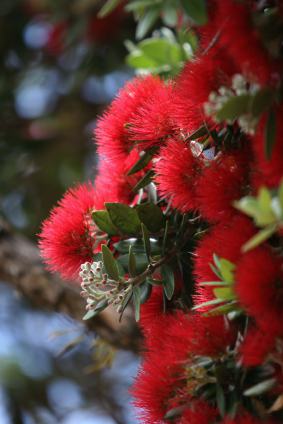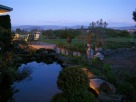- Home
- Attractions
- Hamurana
Hamurana Springs Walk
Hamurana Springs is a wonderful place to perk yourself up with a non-strenuous short walk (½hr tops) in a tranquil setting, far away from the drama of daily life. And the water! Crystal clear but laced with shades of turquoise, jade and emerald, it looks so inviting it's hard to resist throwing your clothes off and diving right in. Visit yourself then tell me if I'm wrong.
Hamurana Springs Reserve
The Reserve is made up of the Hamurana Stream, a scenic walking track through a Redwood Grove, the main spring Te Puna-a-Hangarua, the Dancing Sands Spring and a wide variety of wildlife.
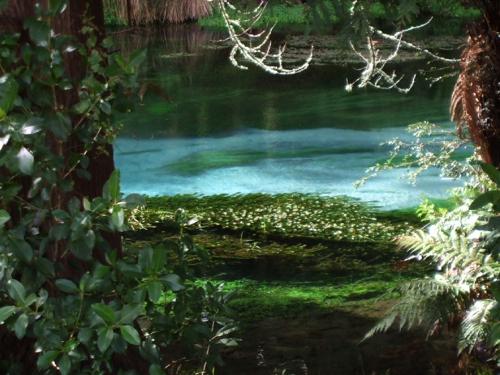 Hamurana Stream
Hamurana StreamIt's adjacent to the Hamurana Golf Club (if that's a bit of you) and Lake Rotorua is just across the road.
Sidenote: As
kids we used to swim in the icy cold Hamurana Stream then race into
the lake to warm up. Brrr, I can still feel it now. The lake felt like a
lovely warm bath after the stream. It's so cold you get a headache
from diving beneath the surface too much. Of course, that doesn't stop children, does it?
In recent times a committed group of local people formed the Hamurana Springs Incorporated Society (HSIS) to bring this natural attraction back to its' former glory after years of neglect. Along with the Department of Conservation (DOC) and the Ngāti Rangiwewehi people who have centuries of tribal association with the springs, a lot of ongoing work has been put into the reserve.
The water for the springs and stream actually comes down from the Mamaku Plateau. Believe it or not, it takes about 70yrs for the water to make its way through underground aquifers (rock that can contain or transmit water) and subsequently resurfaces at the spring. How cool is that?
It then flows downstream into Lake Rotorua → through the Ohau Channel into Lake Rotoiti → off into the Okere Falls Gorge and Kaituna River → all the way to Maketu and the Pacific Ocean. Maketu is where the Arawa waka (canoe) first hit the shores of this country.
Walking Directions
From the carpark you will see a wooden bridge that crosses over the Hamurana Stream. The route runs alongside the stream to the springs then circles back on the opposite side of the stream.
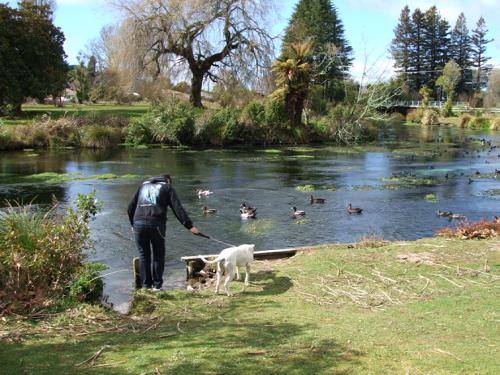 My niece's husband Kaine with Klutch at Hamurana Stream
My niece's husband Kaine with Klutch at Hamurana StreamThe track is very easy and caters to all fitness levels. It's only 800m (½mile) to the spring and would take about 15min to walk. Children and prams are a definite goer for this one.
Mind you, if your children are anything like my daughter they MAY end up in the water. When she was little she thought the greenery on top of the water was grass. Yep, she tried to walk on water and failed miserably. She looked a bit like a leprechaun once hoisted out with all these bits of green stuck all over her.
The Redwood Grove
It is so nice to meander through the Redwood grove on the banks of the Hamurana Stream. With the trees towering overhead and the sun casting dappled shade onto the ground it doesn't get any better. Hopefully you can get a day like that.
These trees are actually native to America and I don't know why they were brought into Rotorua. Maybe it has something to do with them being the tallest trees on earth. They can get up to 100m (328') high. The tallest of our puny ones is 55m (180') with a girth of 2m.
The trees at Hamurana were planted in 1919 and are definitely babies compared to the oldest known one at 2200yrs old.
Behind the grove a tree trust has been created with the help of a local B&B. Their guests can buy a tree and donate it to the trust.
Hangarua Spring & Dancing Sands Spring
The main spring is the largest head spring in the North Island. It's name is Te Puna-a-Hangarua (The Fountain-at-Hangarua) after Hangarua a tribal chieftainess.
There is a story that a female ngarara (water reptile) named Hinerua lived in the spring. Being tame she became the mokai (pet) of a local chieftainess. The "ngarara mokai" would crawl out of her cold water-hole and sun bathe or visit her mistress's kainga (home) and look at the crops.
When the chieftainess died, Hinerua retired to her fountain cave
and disappeared forever. The sightless kokopu (little freshwater fish)
that live in the spring are said to be Hinerua's children.
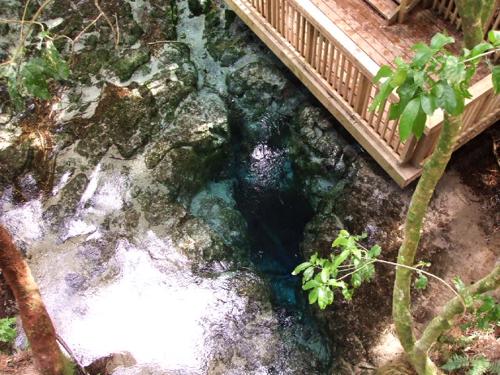 Hangarua Spring
Hangarua SpringLooking down into the spring itself, the volcanic (rhyolitic) sides are made up of ledges with lots of nooks and crannies. Ever since I can remember, people have thrown coins into the spring. The coins dance about on the up-current as they sink and can be seen resting on some of the ledges.
In 1957, pioneer divers from Wellington recovered 5000+ pennies from the spring which were donated to local children's charities.
The spring is 290m (920ft) above sea-level with a depth of 15m (50ft). The temperature is a constant coolish 10ºC (51ºF). I thought it would have to be way below 0º.
The water coming out of this spring everyday is enough to fill 2 olympic sized swimming pools. That sure is a lot of water isn't it?
Continuing on, the walk then makes it's way a bit further along to the Dancing Sands Spring.
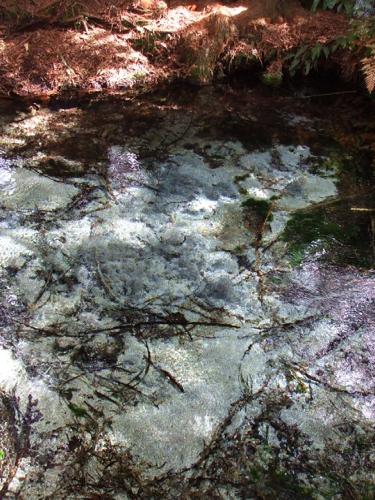 Dancing Sands Spring - Can you make out the little clouds of sand?
Dancing Sands Spring - Can you make out the little clouds of sand?This one is funny. The white and black sand bubbles away throwing up little clouds that dance and sparkle when caught by the light. Very pretty.
This spring is very shallow and looks to be about 10-30cm deep.
Pricing
With no grand announcement and no website that I can find, Hamurana Springs became a paid attraction (Oct 2017) when a sign displaying prices appeared overnight.
You pay at the entrance. Whether they take cards or not I don't know. Will check it out and report back once I get an answer.
Adult: $18
Children 10-15yrs: $8
Children <10Yrs: Free
Family: $30 for 2 adults plus up to 3 children
Local Annual Pass: $30 for 2 adults plus up to 3 children (proof of address required)
Eats
You can take your pick of scenic areas to have a picnic. Just imagine, a lovely hot day, picnic basket filled with goodies, snoozing on the grass beside the stream or under a shady tree. That's the life.
If you are wanting to purchase food or drinks beforehand, there is a little shop on the Hamurana Rd heading towards Ngongotaha although I don't know how good it is. It's more like a dairy.
Probably the best bet would be to pick up something in Ngongotaha on your way out of Rotorua, they have good bakeries and cafes or if you're coming from the other direction, the Okere Falls Store has great coffee and food.
Getting to Hamurana Springs
If you want to make it a round trip, the Springs are about 17km (10½mi) and 22mins west out of Rotorua (via Ngongotaha). See the google map for directions.
Once you see the golf course on your left-hand side you will know that you are just about there.
When you're finished at the springs, carry on around the lake until you get to the main highway.
It makes sense to visit Okere Falls while out that way where there's another lovely short walk. Whitewater rafting can be viewed as well. If that sounds like a good idea, take a left turn and it's 5 or so minutes from there. Otherwise, turn right to return to Rotorua.
Parking & Toilets
As always, carparks for visitors take their turns in being Hotspots for thieves, both for breaking into or taking vehicles. If you can, avoid leaving ANYTHING in your vehicle. In fact, leave the glovebox open and show that there is nothing of value inside. This may deter thieves from breaking a window to gain access.
As for toilets, I couldn't see any the last time that I was out there. I know that there are some across the road on the lake side so until I know for sure I will leave it at that.
Restrictions
For once, you have a place that is actually dog friendly. Apart from that there don't appear to be any restrictions. The area is a wildlife sanctuary as you will see.
Doing your bit to help preserve the balance of life within the reserve means that future generations also get to benefit from these beautiful places.
- Home
- Attractions
- Hamurana
